Q1. Elasticity
I. Price Elasticity of Demand: Amy’s demand for cheesecakes is Qd = 90 – 4P.
a) At price P = 20, what is the price elasticity of demand?
Hint: Use the point elasticity of demand formula to calculate this elasticity. εp = ______. Is it elastic or inelastic at price P = 20? _______
b) Calculate the price elasticity as the price moves from P0 = 20 to P1 = 15 by using the mid-point price elasticity formula (hint: this is the same formula as the arc elasticity formula). εp = _______
c) Calculate the total revenue (TR) at P = 20 and P = 15 separately. When P = 20, TR = ______; when P = 15, TR = ______. Does the total revenue (TR) increase, decrease, or stay the same when the price decreases from P = 20 to P = 15? ______. Use your cal culation of the price elasticity of demand at these two different prices to explain the result in the change of total revenue. __________ .
d) At what price is the price elastic ity of demand equal to 1? P = ________
e) Complete the table below based on Amy’s demand for cheesecakes which is Qd = 90 – 4P.
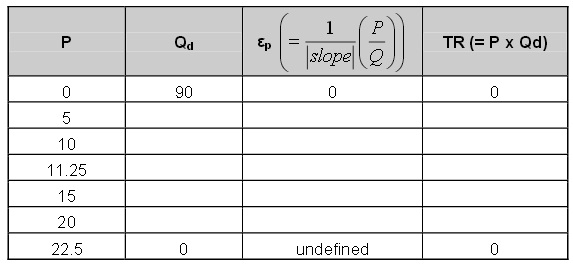
When the elasticity εp > 1: if the price increases, does the total revenue increase, decrease, or remain unchanged? _________. When the elasticity εp < 1: if the price increases, does the total revenue increase, decrease, or remain unchanged? _________.
II. Cross-price elasticity of Demand: Amy substitutes cheesecakes for ice cream sometimes, but Amy always drinks coff ee when she has a piece of cheesecake.
f) The price of ice cream decreases by 10%. As a result, Amy’s demand for cheesecakes decreases from 11 cheesecakes to 9 cheesecakes. What is the cross- price elasticity of demand for Amy for these two goods? Hint: for this calculation just use the % change for price you have been given and then calculate the % change in the quantity demanded using the arc elasticity concept. ε cheesecake pice cream = _________. From Amy’s perspective, is ice cream a substitute or a complement good for cheesecakes? _________ Why? Use the concept of cross-price elasticity of demand to explain your answer. ________
g) The price of coffee increases by 20%. As a result, Amy’s demand for cheesecakes decreases by 15%. What is the cross-price elasticity of demand for Amy for these two goods? ε cheesecake p coffee = __________. From Amy’s perspective, is coffee a substitute or a complement good for cheesecakes? ________ Why? Use the concept of cross-price elastic ity of demand to explain your answer. __________
III. Income elasticity of Demand : Amy got a raise at work, and her income increases by 25%. As a result, her demand for cheesecakes increases by 15%. In the meanwhile, Amy’s demand for jelly decreases by 10%.
h) What is Amy’s income elasticity of demand for cheesecakes? __________ What does this income elasticity tell us about Amy’s valuation of cheesecakes (are cheesecakes normal or inferior goods)? _________
i) What is Amy’s income elasti city of demand for jelly? _________ What does this income elasticity tell us about Amy’s valuation of jelly (is jelly a normal or an inferior good)? _________
Q2. Tariffs and Quotas:
The domestic demand and domestic supply curves for MP3 players in a small closed economy are as follows:
Supply: P = 3Qs + 2
Demand: P = -QD + 102
I. Closed Economy (no trade)
a. Shade the area of consumer surplus (CS) and producer surplus (PS) of the economy without trade on Graph A below. Calculate the value of consumer surplus (CS) and producer surplus (PS) fo r the MP3 player market in this small closed economy. CS = ______, PS = _____
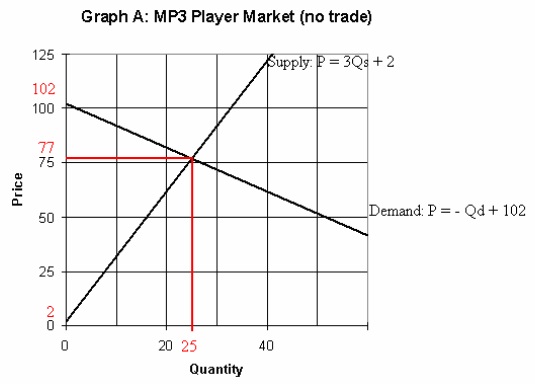
II. Open Economy to Free Trade. Use the following information to answer quest ion a) ~ d). Suppose that this small closed economy is open to free trade and that the world price is $62 per MP3 player.
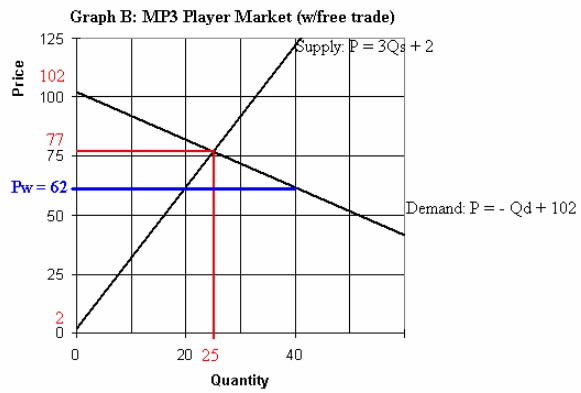
a. What is the quantity supplied by domestic producers?
b. What is the quantity demanded by domestic consumers?
c. With free trade, how many MP3 players wi ll the country import or export?
d. Shade the area of the consumer surplus (C S) and producer surplus (PS) after the economy opens to free trade on Graph B a bove. Calculate the value of consumer surplus (CS) and producer surplus (PS). CS trade = _________ and PS trade = ___________.
III. Open Economy to Trade (with Tariff)
Use the following information to answ er question a) ~ i). Suppose that the government imposes a tariff of $6 on each imported MP3 player, and the world price is $62 per MP3 player.
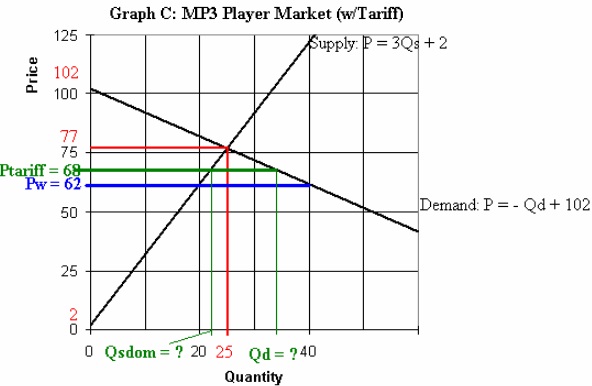
a. What is the quantity supplied by domestic producers after the introduction of the tariff?
b. What is the quantity demanded by domestic consumers after th e introduction of the tariff?
c. How many MP3 players will the country impor t or export after the introduction of the tariff?
d. Shade the areas of the consumer surplus (CS), the producer surplus (PS), the total tariff revenue (TR), and the dead weight loss (DWL) after the introduction of tariffs on Graph C above.
e. Calculate the value of consumer surplus (CS) and the value of producer surplus (PS) for the MP3 player market afte r introducing the tariff. CS w/Tariff = _______ and PS w/Tariff = _____.
f. Calculate the value of total tariff revenue. Tariff Revenue = _________.
g. Calculate the dead weight loss. DWL = ________.
h. Rank the consumer surplus (CS) for the three options from the highest to the lowest: Option 1: the MP3 player market without trade.
Option 2: the MP3 player market with free trade.
Option 3: the MP3 player market with the tariff. _______.
i. Rank the producer surplus (PS) for the th ree options from the highest to the lowest:
Option 1: the MP3 player market without trade.
Option 2: the MP3 player market with free trade.
Option 3: the MP3 player market with the tariff. ______
IV. Open Economy to Trade (w/Quota)
Use the following information to answer que stion a) ~ j). Suppose that the government introduces a quota allowing imports of 8 units instead of introducing tariffs. Suppose that the world price is $62 per MP3 player.
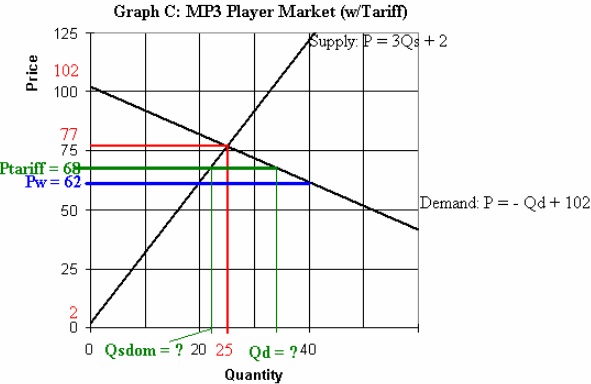
a. What is the quantity demanded by domestic consumers after the introduction of the quota?
b. What is the quantity supplied by domestic producers after the introduction of the quota?
c. How many MP3 players will the country impor t or export after the introduction of the quota?
d. Mark the new supply curve S Quota with a bold line or a colored line on Graph D after the implementation of the quota. Shade the areas of the consumer surplus (CS), the producer surplus (PS), the licen se holder revenue (LHR), and the dead weight loss (DWL) after the introduc tion of the quota on Graph D above.
e. Calculate the value of consumer surplus (CS) and the value of producer surplus (PS) for the MP3 player market afte r introducing the quota. CS w/Quota = _______. PS w/Quota = _______.
f. Calculate the value of total license holder revenue. License Holder Revenue = ______.
g. Calculate the dead weight loss. DWL = _______.
h. Rank the consumer surplus (CS) for the three options from the highest to the lowest:
Option 1: the MP3 player market without trade.
Option 2: the MP3 player market with free trade.
Option 3: the MP3 player market with the quota. ________.
i. Rank the producer surplus (PS) for the three options from the highest to the lowest:
Option 1: the MP3 player market without trade.
Option 2: the MP3 player market with free trade.
Option 3: the MP3 player market with the quota.
j. If the government wants to use the quota policy to attain the equilibrium quantity equal to the domestic quantity demande d under the $6 tariff policy in g), what would be the quantity the government sets for the quota to achieve this goal? _______.
Q3. Nominal vs. Real Prices: Use the following table to answ er the next five questions. The CPIs below are constructed using Year 1960 as the base year (BY = 1960).

I. What will be the CPI measure in year 1980 if we alter the base year to 2008? ________
II. What was the increase in the general price level from 1980 to 2008? _____ If the average salary increased at the same rate as the increase in the general price level, given the nominal average salary was $10,000 in 1980, what should the nominal average salary be in 2008? _______.
III. The nominal price of the minimum wage was $6 per hour in 1980 as well as in 2008. What was the real price of the minimum wage per hour in 1980 using 2008 as the base year? ______
IV. Using the above table of information recalculate the CPI using 1980 as the base year (BY).

Fill in your answers in the table below.
V. Suppose your nominal salary is $60,000 in 2008. You are about to meet with your boss and demand a raise. Given the forecast of the CPI in 2009 in the table above using BY = 1960, what’s the minimum nominal salary you should ask for 2009 in order to maintain the same real wage/purchasing power you get in 2008?